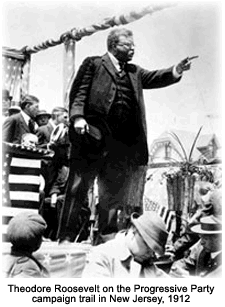The Progressive Party was a factor in the presidential campaigns of three men — Theodore Roosevelt, Robert La Follette, and Henry Wallace. There were a few Progressive Party organizations spanning this period of time but after the 1952 elections, they disappeared entirely.
Its first incarnation came in 1912, when Theodore Roosevelt led progressive elements out of the Republican Party. Roosevelt had made no secret of his low opinion of President William H. Taft and felt he could not support the ticket. Taft had particularly angered Roosevelt, an ardent conservationist, by removing Gifford Pinchot as chief forester.
 Roosevelt struck out on his own and formed the first Progressive Party, saying he was as fit as a bull moose, from which came the colloquial name "Bull Moose Party." His platform called for tariff reform, stricter regulation of industrial combinations, women’s suffrage, prohibition of Child Labor, and other reforms.
Roosevelt struck out on his own and formed the first Progressive Party, saying he was as fit as a bull moose, from which came the colloquial name "Bull Moose Party." His platform called for tariff reform, stricter regulation of industrial combinations, women’s suffrage, prohibition of Child Labor, and other reforms.
The new party nominated Roosevelt for president and Hiram Johnson for vice president. Although the Progressives finished well ahead of Republicans in the election, they lost to the Democratic candidate, Woodrow Wilson. When Roosevelt returned to the Republican fold in 1916, the Progressive Party vanished for a time.
In 1924, liberals were so frustrated with conservative control of both major political parties that they formed the League of Progressive Political Action, better known as the Progressive Party. Robert La Follette of Wisconsin, a Republican, decided to run for president as an independent, but later accepted the nomination from the Progressive Party. Senator Burton K. Wheeler, a Democrat from Montana, was nominated for vice-president.
The party advocated government ownership of public utilities and such labor reforms as collective bargaining. It also supported farm-relief measures, lower taxes for persons with moderate incomes, and other such laws. Although La Follette received 17 percent of the popular vote, he only carried Wisconsin’s electoral vote.
In 1934, La Follette’s sons organized a progressive party in Wisconsin. Robert La Follette, Jr. was elected to the Senate but was beaten in 1946 by Joseph McCarthy.
Yet another progressive party was formed in 1948. Former New Deal Democrats had become dissatisfied with the policies of Harry Truman and wanted their own party. They nominated Henry A. Wallace for president and Glen H. Taylor for vice president. They advocated liberal policies that included rights for minorities, curbs on monopolies, and the repeal of the Taft-Hartley Act.
 The party`s platform should have appealed strongly to blacks, intellectuals, and labor union members, but the support given them by the Communist Party was used against them by both major parties. The progressives maintained their right to accept support from any group. This was high-principled but politically fatal. Wallace received only 2.4 percent of the popular vote and carried no state.
The party`s platform should have appealed strongly to blacks, intellectuals, and labor union members, but the support given them by the Communist Party was used against them by both major parties. The progressives maintained their right to accept support from any group. This was high-principled but politically fatal. Wallace received only 2.4 percent of the popular vote and carried no state.
In 1950, the party opposed America`s decision to fight in Korea. Wallace split with the party`s leadership on the issue and resigned from the party. The Progressive Party disappeared after the 1952 election. Only time will tell if another progressive party will be formed.